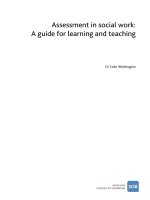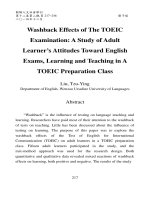Bibliography Useful Sources for Learning and Teaching English through Drama
Bạn đang xem bản rút gọn của tài liệu. Xem và tải ngay bản đầy đủ của tài liệu tại đây (67.72 KB, 5 trang )
Learning English through Drama
Bibliography: Useful Sources
for Learning and Teaching English through
Drama
Books on EFL Drama Classroom
Bernardi, P. (1992). Improvisation Starters. (Cincinnati: Betterway Books)
Burke, A.F. & O’Sullivan, J. C. (2002). Stage by Stage: A Handbook for Using Drama in
the
Second Language Classroom. (Portsmouth: Heinemann)
Cassady, M. (1993). Acting Games: Improvisations and Exercises. (Colorado Springs:
Meriwether Publishing)
Dougill, J. (1987). Drama Activities for Language Learning. (London: Macmillan)
Heinig, R. (1988). Drama for the Classroom Teacher. 3rd ed. (Englewood Cliffs: PrenticeHall)
Levy, G. (2005). 112 Acting Games. (Colorado Springs: Meriwether)
Maley, A., & Duff, A. (2005). Drama Techniques: A Resource Book of Communication
Activities for Language Teachers. (Cambridge: CUP)
McCaslin, N. (1996). Creative Drama in the Classroom and Beyond. 6th ed. (White
Plains: Longman)
Spolin, V. (1986).Theater Games for the Classroom: A Teacher's Handbook. (Evanston:
Northwestern University Press)
Wessels, C. (1987). Drama. (Oxford: Oxford University Press)
Websites
Using Drama in the Language Classroom
“Add Drama to an EFL Class”
/>“ChildDrama.com”
/>“Drama Techniques for Teaching English”
/>“Listening to Body Language”
/>
T 73
Learning English through Drama
“Overcoming the Fear of Using Drama in English Language Teaching”
/>“Vocabulary Teaching Using Student-Written Dialogues”
/>“Web English Teacher: Theater Resources”
/>
Lesson Plans
“Drama in Education: Materials”
/>“Film Festival: An ESL Lesson Plan to Get Students Talking about Movies”
/>“Lesson Plans”
/>
Warm-ups and Other Drama Games
“Improv Games”
/>“learnimprov.com”
/>“Warm-ups”
/>
Drama Vocabulary
“ESL Test – Expressing Emotions”
/>“Movie Review Query Engine”
/>“Online English Vocabulary Exercise – Emotions and Feelings 1”
/>“Online English Vocabulary Exercise – Emotions and Feelings 2”
/>
T 74
Learning English through Drama
“Online English Vocabulary Exercise – Emotions and Feelings 3”
/>“Vocabulary Exercises – Art and Entertainment”
/>
Pronunciation, Stress and Intonation
“American Rhetoric – Movie Speeches”
/>“howjsay.com – an English Pronouncing Dictionary with Instant Sound”
/>“Minimal Pair Practice & Quizzes”
/>“Pronunciation – Oxford University Press”
/>“Sentence Stress in English”
/>“Sounds of English – Tips for Teachers”
/>“The Speech Accent Archive”
/>
Reader’s Theatre
“Aaron Shepard’s RT Page – Scripts and Tips for Reader’s Theater”
/>“Gander Academy Readers Theatre”
/>“Teaching and Learning: The Power of Reader’s Theater”
/>“Web English Teacher – Reader’s Theater”
/>
T 75
Learning English through Drama
Scripts and Clips
“American Rhetoric – Movie Speeches”
/>“Drew’s Script-o-Rama”
/>“Horton’s Stage Page”
o/index.html
“storiestogrowby.com”
/>
Other Books on Acting/Directing
Ball, W. (1984). A Sense of Direction: Some Observations on the Art of Directing.
(Hollywood: Drama Publishers)
Benedetti, R. (2006). The Actor in You. 3rd ed. (Boston: Pearson Education)
Bruder, M. (1986). A Practical Handbook for the Actor. (New York, Vintage Books)
Chubbuck, I. (2004). The Power of the Actor. (New York: Gotham Books)
Guskin, H. (2003). How to Stop Acting. (London: Faber and Faber)
Hagen, U. (1991). A Challenge for the Actor. (New York: Scribner)
Hauser, F. & Reich, R. (2003). Notes on Directing. (New York: RCR Creative Press)
Jory, J. (2000). Tips: Ideas for Actors. (Lyme, NH: Smith & Krause)
Ibid. (2002). Tips: Ideas for Directors. (Lyme, NH: Smith & Krause)
Ibid. (2004). Tips II: More Ideas for Actors. (Lyme, NH: Smith & Krause)
Meisner, S. & Longwell, D. (1987). Sanford Meisner on Acting. (New York: Vintage
Books)
Moss, L. (2005). The Intent to Live: Achieving Your True Potential as an Actor. (New York:
Bantam)
Nicola, J. P. (2002). Playing the Audience: The Practical Actor’s Guide to Live
Performance. (New York: Applause Theatre & Cinema Books)
Shapiro, M. (1998). The Director’s Companion. (Belmont, CA: Wadsworth)
Ibid. (2006). An Actor Performs. 2nd ed. (Belmont, CA: Wadsworth)
Shurtleff, M. (1978). Audition. (New York: Bantam)
Silverberg, L. (1994). The Sanford Meisner Approach: An Actor’s Workbook. (Lyme, NH:
Smith & Krause)
T 76
Learning English through Drama
Ibid. (1997). The Sanford Meisner Approach: Workbook Two – Emotional Freedom.
(Lyme, NH: Smith & Krause)
Ibid. (1998). The Sanford Meisner Approach: Workbook Three – Tackling the Text. (Lyme,
NH: Smith & Krause)
Ibid. (2000). The Sanford Meisner Approach: Workbook IV – Playing the Part.
(Lyme, NH: Smith & Krause)
Spolin, V. (1985). Theater Games for Rehearsal: A Director’s Handbook. (Evanston, IL:
Northwestern University Press)
Ibid. (2001). Theater Games for the Lone Actor: A Handbook. (Evanston, IL:
Northwestern University Press)
Waxberg, C. (1998). The Actor’s Script: Script Analysis for Performers. (Portsmouth:
Heinemann Books)
Witcover, W. (2004). Living on Stage – Acting from the Inside Out. (New York: Back
Stage Books)
T 77









